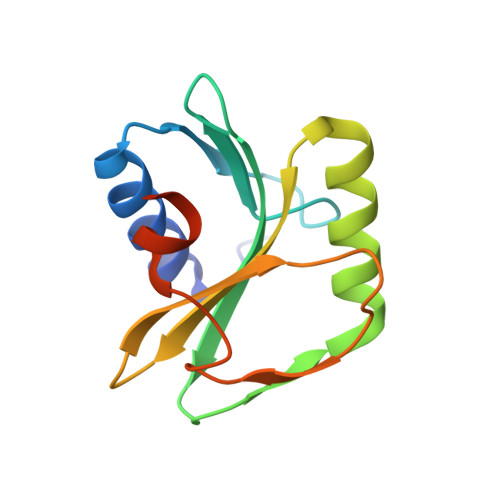Dissection of the regional roles of the archaeal Holliday junction resolvase Hjc by structural and mutational analyses.
Nishino, T., Komori, K., Ishino, Y., Morikawa, K.(2001) J Biol Chem 276: 35735-35740
- PubMed: 11441015
- DOI: https://doi.org/10.1074/jbc.M104460200
- Primary Citation of Related Structures:
1IPI - PubMed Abstract:
Hjc is an archaeal DNA endonuclease, which resolves the Holliday junction in the presence of divalent metals. Combined with mutational analyses, the x-ray structure of the Pyrococcus furiosus Hjc crystal grown in the presence of ammonium sulfate revealed a positively charged interface, rich in conserved basic residues, and the catalytic center (Nishino, T., Komori, K., Tsuchiya, D., Ishino, Y., and Morikawa, K. (2001) Structure 9, 197-T204). This structural study also suggested that the N-terminal segment and some loops of Hjc play crucial roles in the cleavage of DNA. However, a structural view of the interaction between these regions and DNA remains elusive. To clarify the regional roles of Hjc in the recognition of the Holliday junction, further structural and biochemical analyses were carried out. A new crystal form of Hjc was obtained from a polyethylene glycol solution in the absence of ammonium sulfate, and its structure has been determined at 2.16-A resolution. A comparison of the two crystal structures has revealed that the N-terminal segment undergoes a serious conformational change. The site-directed mutagenesis of the sulfate-binding site within the segment caused a dramatic decrease in the junction binding, but the mutant was still capable of cleaving DNA with a 20-fold lower efficiency. The kinetic analysis of Hjc-Holliday junction interaction indicated that mutations in the N-terminal segment greatly increased the dissociation rate constants of the Hjc-Holliday junction complex, explaining the decreased stability of the complex. This segment is also responsible for the disruption of base pairs near the junction center, through specific interactions with them. Taken together, these results imply that, in addition to the secondary effects of two basic loops, the flexible N-terminal segment plays predominant roles in the recognition of DNA conformation near the crossover and in correct positioning of the cleavage site to the catalytic center of the Hjc resolvase.
Organizational Affiliation:
Department of Structural Biology and Department of Molecular Biology, Biomolecular Engineering Research Institute, 6-2-3 Furuedai, Suita, Osaka 565-0874, Japan.














